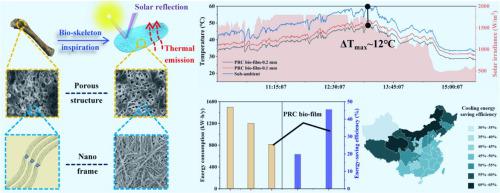Chemical Engineering Journal ( IF 13.3 ) Pub Date : 2022-09-22 , DOI: 10.1016/j.cej.2022.139377 Shuangjiang Feng , Yuming Zhou , Chenghuan Liu , Tao Zhang , Xiaohai Bu , Yuzhong Huang , Man He

|
To alleviate the energy consumption and CO2 emission caused by the operation of electrical equipment in hot weather, passive radiative cooling (PRC) has been considered as an effective strategy owing to the non-power input and non-pollution. In spite of exciting process, PRC materials are still limited by the poor optical selectivity in practical applications. Herein, inspired by the potential optical-thermal properties of the porous structure and composition of skeleton, ultra-thin hydrophobic sodium alginate (SA) cellulose bio-film was designed including precisely 3D porous structure like skeleton and ultra-long hydroxyapatite nanowires (HAP ULNWs) as self-assembled supporting frame. The obtained bio-film could reflect more than 95.59% of solar radiation only within ultra-thin scale (∼220 μm) as well as emit 96.73% of thermal radiation. As the proof, the bio-film was used for the outdoor radiative cooling and about 12℃ maximum cooling effect could be obtained during the daytime under high solar radiation power density (>1750 W/m2). For evaluating the energy-saving potential, a building model covered with PRC film was established and 48.67% of average electric energy consumption could be saved per year in China. The work presents an alternative strategy to enhance the optical selectivity and may facilitate the high-performance cooling energy saving.











































 京公网安备 11010802027423号
京公网安备 11010802027423号